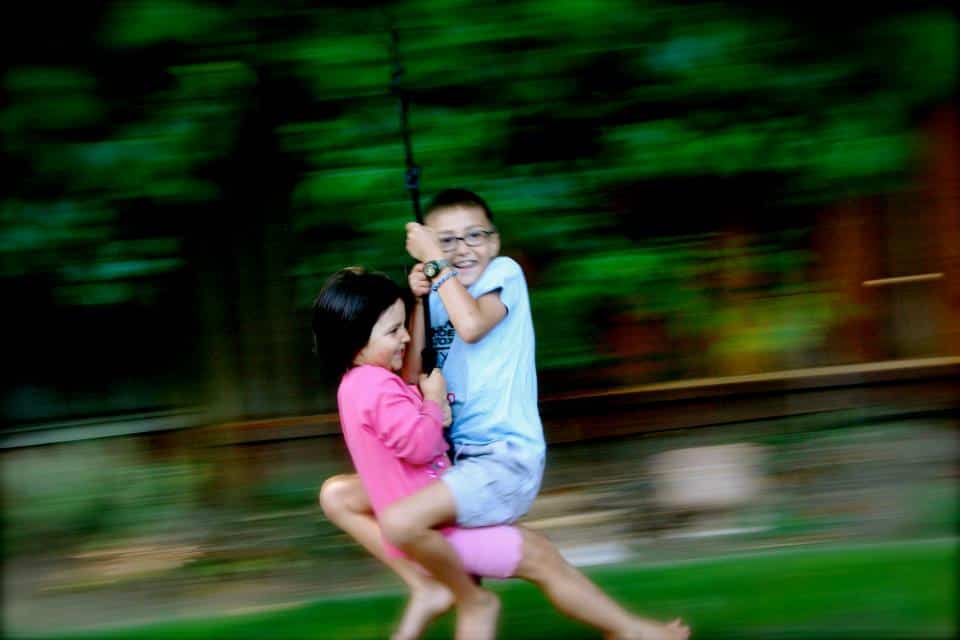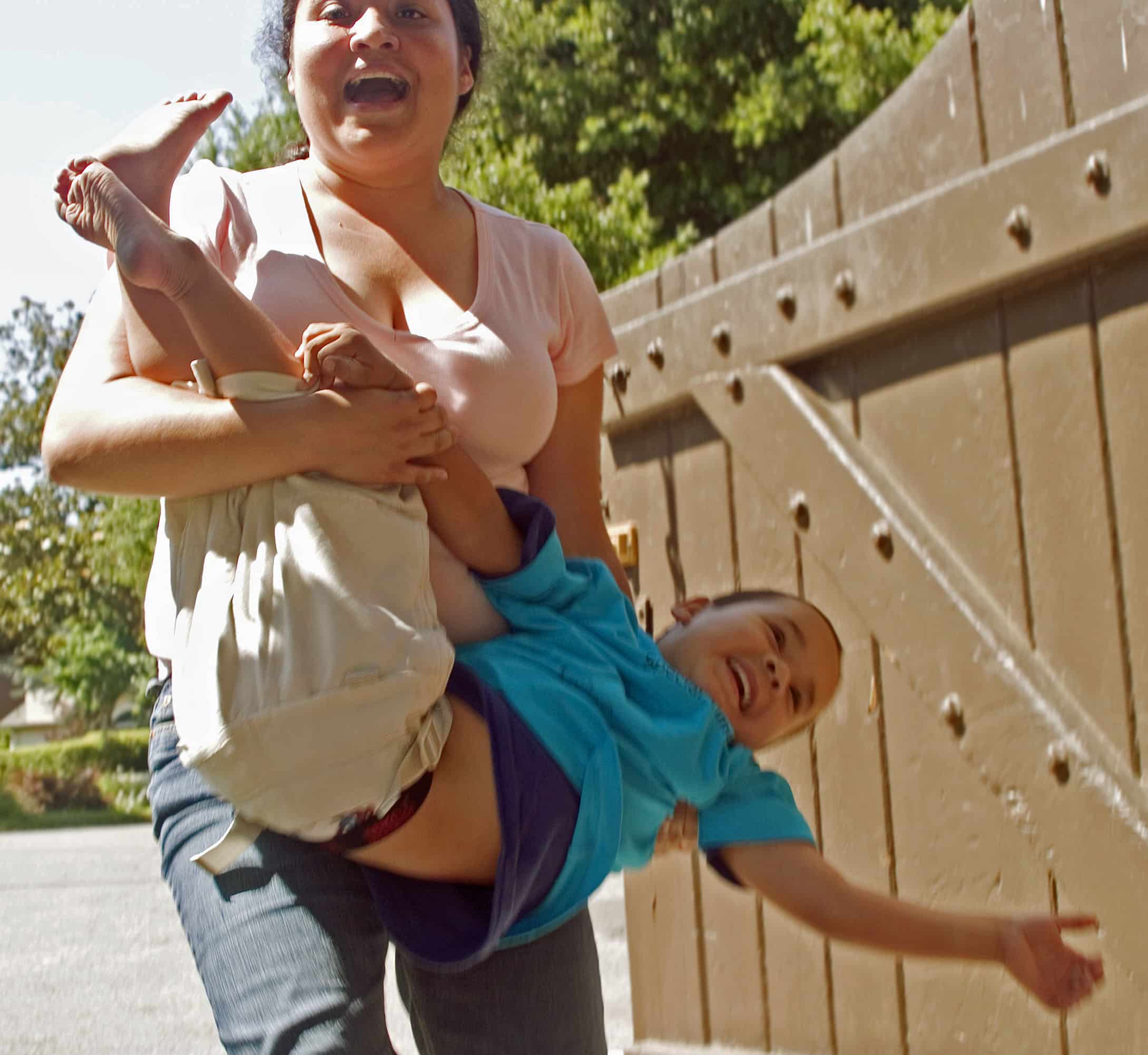“My son is struggling in school. He loved it at first, but now he’s getting into trouble. He wants to play more, he gets other children laughing, and disrupts what the teacher is trying to do. I know he’s a good boy. What can I do to help him? They’re talking about evaluating him for ADD and ADHD.”
In our busy world, children often don’t get the extended hours to play and experiment that their young minds need in order to thrive. So the problems many people see as children's attention issues are actually generated by too much time spent environments in which children are expected to “behave.”
When a restricted environment isn’t balanced out by an hour or more a day when children can run hard, laugh hard, wrestle, be daring, and engage in spontaneous play, the strain shows in their behavior.
The symptoms that trigger diagnoses can and often are the result of “APP”–Absence of Physical Play.

But some children do indeed have chronically short attention spans.
The set of behaviors that has come to define ADD and ADHD is the same set of behaviors that a child must adopt if he has been deeply frightened at some time in his life.
A child who has been frightened has to distract himself from feeling a deep panic about whether or not he is going to survive, or whether or not he is fully OK.
To keep those fears from paralyzing him, a child has to keep moving, keep talking, stay active enough to distract his emotional mind from the tension that resides there.
He’ll tend to be impulsive on any pretext, or no pretext at all.
Sometimes, a child becomes aggressive.
This aggression comes from a deep sense of vulnerability. A child feels that he must lash out to keep himself safe from danger. The danger that instilled the child with fear in the first place is now long past, but the child’s mind has stored the emotion he experienced during that threatening experience.
He can't relax.
Fear generates a low-level emotional tension in most of his interactions that can escalate at any time.
(Most children who are labeled ADD or ADHD had long, intense crying jags as infants. They were trying hard to release the emotional tension that landed on them early in their existence. We parents aren’t schooled in how to support an infant, how to settle in, welcome the crying, and reassure him or her while this stored tension is making its exit.
So a child’s attempts to heal create a dynamic of anxiety and frustration in the parent-child relationship. As his parents become more frantic to help, the child feels fear on top of fear.
No parent is at fault for this! There are, as yet, very few places one could learn about emotional support for infants and toddlers who have a high need to release stored feelings.)
Fear is not an easy emotion for children, or for any of us, to cleanse from our systems. To be good at helping our children with their fears, we parents have to learn to do our own emotional work. We have been worn down over time. We love our children, but the parenting job has been hard! We need to talk about and release the emotional tension has been building. Until we do, we’re as easily triggered as our child. I'll say more about this in a moment.
 Whether your child just needs more vigorous playtime, or has some fears that interfere with his attention span, I’ll outline some strategies that, used consistently, can ease your child’s behavior at home and at school.
Whether your child just needs more vigorous playtime, or has some fears that interfere with his attention span, I’ll outline some strategies that, used consistently, can ease your child’s behavior at home and at school.
Physical play begins the healing process for children's attention issues
What an easily distracted child needs is lots of physical play—the kind of play we call roughhousing, or horsing around. Pillow fights, wrestling, allowing a child to jump on the bed or sofa while you try to “catch” their feet, for example. I call this kind of play “Playlistening.” The adult plays the less powerful role, with a generous, affectionate tone, “losing” in play again and again, but working the play slowly but surely toward more and more affection, more and more bodily contact, more and more cuddling and vigorous snuggles.
As a frightened child feels the tone of affection, he’ll playfully fight back, or dance away. As the Playlistening parent, you keep following, keep playfully “wanting” him. Follow the child’s lead. You don’t overwhelm, you don’t trap, you don’t win. Many times, you play that your child has fooled you, or has escaped your grasp. In particular, whatever lets your child laugh is what you set up in play over and over and over again. The laughter is your indication that the play has become a healing interaction. Laughter begins the healing of fear, and helps children feel safe and close to you.
In the play you cook up with your child, make sure that everything you do communicates that you won't overwhelm him. Fall when he pushes you, groan when a pillow hits you, but keep coming back for more. Want your child! Make eye contact often. Offer your child lots of little unpredictable but survivable challenges. Your child is working on survival issues, in some deep sense. So every time you try to catch his feet while he jumps out of range on the bed, he’s “survived” a “threat” and he’ll laugh and laugh. Of perhaps you've got your child riding on your back, and your partner is affectionately chasing the two of you through the house, trying to give your child a hug and a kiss. Your partner’s hand touches your child, but you dart away, “saving” him from the “clutches” of his Daddy or Mommy, who wants a hug. The jostling on your back and the last minute “escapes” from being caught and snuggled will give your child the chance to laugh again and again.
Follow the laughter. For some children, the laughter comes best when you're throwing pillows at them from 10 feet away, and you miss. If you get closer, they tighten up and can't laugh–the play gets too threatening for them, and they screech instead. So for months, play with them from 10 feet away, then 9 feet, then 8 feet, letting their laughter and your patience increase their confidence slowly but surely. For other children, who are aggressive and want to hurt at some point in the play, you need to come back “at” them very vigorously, to meet with confidence the force they exert against you. If the child dishes out hard hits with a pillow, for instance, respond by dishing out body shots that are almost that hard (scaled to the child’s size and strength, of course). You stay playful, but you snuggle them hard, or you “pound” on them playfully, or you drop them down on the bed, where they bounce back safely but laugh hard because you understood that they need that kind of challenge.
This kind of play on a regular basis is very helpful to children who are easily distracted. The laughter is just what they need to begin to feel safer in the world. All those little survival experiences build their confidence in themselves and in you. And the physical contact is deeply reassuring. With a good playful pounding or a good physical tussle, every cell of their bodies “gets” the signal that they are that they are now strong, that they survived. This counters the fear they carry, and lets their mind operate more freely.
For a frightened child, physical play will escalate into aggression
Once you begin this kind of physical play, a child will set up more and more times, both in the play, and on other occasions, when he openly and obviously crosses the line into behavior that must be limited. Frequently, after some minutes of successful, flexible playtime, your child will begin to tighten. His face will lose its flexibility, and you’ll see the buried emotion bubble to the surface. You’ve created the safety for him to show you his troubles. Some children escalate the fear-based behavior gradually, and others laugh and play hard, then lash out suddenly, trying to hurt you, or breaking something deliberately. The fear grabs their minds and they go flamingly off track. That's your signal to move in close and start the more challenging part of the healing process, Staylistening.
Move in and bring a physical limit
Stop your child’s off-track behavior. Don’t rely on words! Don’t give a verbal order. Your child can’t process anything you say while in the grip of the fear that governs his mind at this moment. He is wild with emotion. Move in and stop him, physically, without any tone of punishment or blame. “I can’t let you hurt me.” Or “I can’t let you do that,” is a good thing to say, but 90% of your communication to your child is through the physical barrier you set with your body.
If you're able to move in close and stay there, a child will immediately go into the release of fear. Deep fear releases when a child is able to struggle, cry, sweat, rage, tremble in upset, and feel utterly panicked or outraged.
Staylisten, to help your child recover a sense of safety
As you hold a limit, and stay close to your child, probably holding him in your arms, or lying next to him while he flails and struggles, your child will tremble, perspire, scream, flail, and feel like his life is ending. He will be furious with you, and will aim all that fury right at you. This is the emotional charge that drives your child’s impulsive acts. This is the fire inside, that keeps him from relaxing into learning endeavors or social interactions. Let him show you all that fear and fury. Let him go wild with upset. Stay close. Tell him you won’t leave him feeling this badly, and stay until the feelings have subsided. This emotional outpouring can take ten to sixty minutes or more. But when the feelings have run their course, with you paying close attention, offering a safe place in your arms, and keeping your child from doing damage in the process, he will feel deeply and thoroughly relieved.
This is a profound process. Most of us have never seen anything like it. An adult stays with a wildly passionate child, listens and cares and keeps things safe, without punishment or hurry. The adult trusts that the child is doing what he needs to do, and supports the child’s emotional process, without taking offense. A fuller description of what a child will do, and how an adult can respond so that the child emerges less frightened, more confident, and very much more reasonable and calm, is in the booklet “Healing Children’s Fears,” part of the set, “Listening to Children,” published by Hand in Hand Parenting. Several articles at our website, available for free, also describe this process, and on ourblog, you can read many anecdotes from parents that help give a feel for the kind of emotional support that changes children’s lives.
You need support, too!
Back to the topic of building support for this work, as parents. Most of us weren't brought up with parents who wrestled with us, were happy with squirt gun battles, or chased us around the house trying to get in one more big snuggle.
Many dads struggle with being too forceful in play, and most moms struggle with feeling at home with it. We're trying to give what was never given to us, and we're trying to have sensitivity to children's signals that is far from the blunt, cookie-cutter responses our parents could come up with, hard as they tried.
And then, when our children do go into the fighting, scratching, clawing beginnings of the release of their deep-seated fear, it's hard to hang in with them. It's scary for us to see that much raw emotion, that unvarnished panic, that look that says, “I’ll hurt you if I can,” that's a part of cleansing one's system of stored feelings of terror. So in order to Staylisten to a child who’s been labeled ADD or ADHD, or any frightened child, we need to find a good listener. We need to grieve for our children, for the moments and days they had that set them up to feel so frightened.
Sometimes the source of the child’s fear is adoption, sometimes it's prenatal experiences, sometimes it's birth, sometimes it's medical treatment early in their lives, and sometimes, we just don't know what it is. We don't need to know what laid in their fears in order to help them shed those feelings, but we do need to shed the tension we carry so we can keep increasing our awareness, and keep remembering that we are partnering with them. Children’s instinct to heal is strong. To meet the bids for help they keep issuing, we need to work on our own feelings about our history as parents. No one tells us that we’re going to need emotional support for the work of parenting! But once you begin to get that help, that listening time, you’ll never go back to being without it. You, too, are worthy of time, care and the support of a listener.
Save
Save
